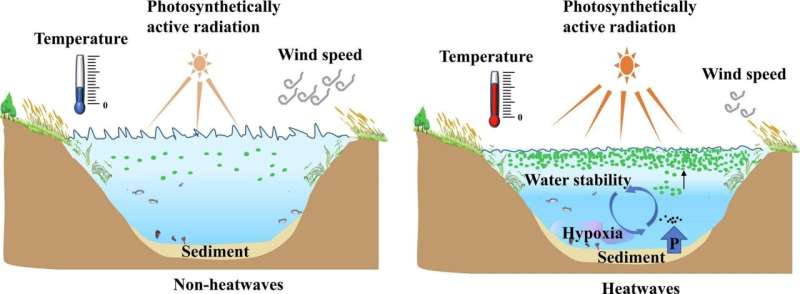This article has been reviewed according to Science X's editorial process and policies. Editors have highlighted the following attributes while ensuring the content's credibility:
fact-checked
peer-reviewed publication
trusted source
proofread
Linking the mechanics of lake heat waves and potentially poisonous blooms

Eutrophication, the cycle whereby nutrients overstimulate the growth of potentially harmful plankton and cyanobacterial "blooms" in freshwater lakes, has become a problem for more than 60% of global inland waters. The problem is set to be exacerbated by climate change, and so our priority should be to further reduce external nutrient inputs to diminish the basis of cyanobacterial bloom outbreaks.
The study of one lake in China, an important source of water for more than 20 million people and for industry, establishes the mechanisms between lake heat waves and potentially poisonous cyanobacteria blooms.
The research by Dr. Iestyn Woolway of Bangor University and research colleagues in the Chinese Academy of Sciences, Nanjing, China and Aarhus University, Denmark, published in Science of the Total Environment studies the heat wave experienced in 2022 in Lake Taihu, one of China's largest freshwater lakes situated in the Yangtze delta, and the associated cyanobacteria blooms. (Cyanobacterial are similar to plankton. Under certain conditions they can thrive in freshwater causing harm to other plants and animals).
Increasing surface air temperature is one of the most recognized consequences of man-made climate change. In lakes, these conditions are exacerbated by "run-offs" from other human activities which add nutrients to the lakes, these in turn, help the cyanobacteria to thrive. An increase in lake surface water temperature has a knock-on effect on the entire lake environment.
Woolway says, "In addition to reducing run-off into freshwater as a result of our activities, we should be working towards systematic monitoring, prediction and early warning to reduce the damaging impact of heat waves on lake ecosystems. We need to better understand the mechanisms and triggers in lakes with different nutrient levels in order to formulate strategies to address and adapt to climate change.
"The whole thing becomes a vicious circle when heat waves occur. An increased temperature reduces vertical mixing within the freshwater water column. This benefits buoyant cyanobacteria floating and forming dense surface blooms. These dense blooms, in turn, slightly increase the water temperature.
"The lower winds experienced during heat waves also contribute to reduced mixing in the water column and reduce dissolved oxygen in the water. In turn, the low dissolved oxygen levels at the lake bottom increase the release of phosphorus from the sediment, which then supports further growth of more cyanobacteria.
"Heat waves are predicted to increase eleven-fold during this century, and this will have profound negative effects on the structure, function, and ecosystem services of aquatic systems."
More information: Na Li et al, The unprecedented 2022 extreme summer heatwaves increased harmful cyanobacteria blooms, Science of The Total Environment (2023). DOI: 10.1016/j.scitotenv.2023.165312
Journal information: Science of the Total Environment
Provided by Bangor University



















